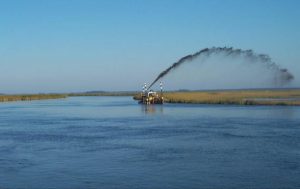Novel sediment management strategies to be explored for protecting coastal wetlands

SCCWRP and its partners have launched a four-year study exploring how innovative sediment management strategies could be used to prepare low-lying coastal areas for the impacts of sea level rise and storm surge.
The project, which kicked off in June and is being led by the University of California, Irvine, will analyze how existing sediment management practices affect the stability of Southern California wetlands and other coastal habitats vulnerable to rising sea levels, and how novel sediment management strategies could be used to optimally protect these areas and help them adapt in the coming decades.
In particular, researchers will examine how raising the elevation of wetlands by spreading layers of sediment over them – known as accretion – might buffer these areas and help preserve their ecological functioning.
Case studies will be conducted in Upper Newport Bay in Orange County and the Tijuana River Estuary in San Diego County.
Because any sediment management strategies developed through the project will need to be responsive to competing management priorities and needs, researchers will develop models to help managers systematically evaluate tradeoffs related to ecological restoration, water-quality protection, navigation, recreation and other priorities.
During the project’s kickoff meeting in June, representatives from more than a dozen federal, state and local agencies involved in coastal habitat management helped define future research needs, identify possible strategies and summarize data gaps related to sediment management as an accommodation tool.
More news related to: Climate Change, Sea Level Rise